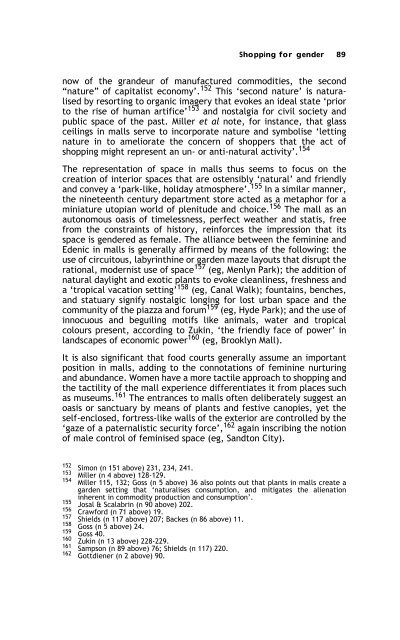Sex, Gender, Becoming - PULP
Sex, Gender, Becoming - PULP
Sex, Gender, Becoming - PULP
Create successful ePaper yourself
Turn your PDF publications into a flip-book with our unique Google optimized e-Paper software.
Shopping for gender 89<br />
now of the grandeur of manufactured commodities, the second<br />
“nature” of capitalist economy’. 152 This ‘second nature’ is naturalised<br />
by resorting to organic imagery that evokes an ideal state ‘prior<br />
to the rise of human artifice’ 153 and nostalgia for civil society and<br />
public space of the past. Miller et al note, for instance, that glass<br />
ceilings in malls serve to incorporate nature and symbolise ‘letting<br />
nature in to ameliorate the concern of shoppers that the act of<br />
shopping might represent an un- or anti-natural activity’. 154<br />
The representation of space in malls thus seems to focus on the<br />
creation of interior spaces that are ostensibly ‘natural’ and friendly<br />
and convey a ‘park-like, holiday atmosphere’. 155 In a similar manner,<br />
the nineteenth century department store acted as a metaphor for a<br />
miniature utopian world of plenitude and choice. 156 The mall as an<br />
autonomous oasis of timelessness, perfect weather and statis, free<br />
from the constraints of history, reinforces the impression that its<br />
space is gendered as female. The alliance between the feminine and<br />
Edenic in malls is generally affirmed by means of the following: the<br />
use of circuitous, labyrinthine or garden maze layouts that disrupt the<br />
rational, modernist use of space 157 (eg, Menlyn Park); the addition of<br />
natural daylight and exotic plants to evoke cleanliness, freshness and<br />
a ‘tropical vacation setting’ 158 (eg, Canal Walk); fountains, benches,<br />
and statuary signify nostalgic longing for lost urban space and the<br />
community of the piazza and forum 159 (eg, Hyde Park); and the use of<br />
innocuous and beguiling motifs like animals, water and tropical<br />
colours present, according to Zukin, ‘the friendly face of power’ in<br />
landscapes of economic power 160 (eg, Brooklyn Mall).<br />
It is also significant that food courts generally assume an important<br />
position in malls, adding to the connotations of feminine nurturing<br />
and abundance. Women have a more tactile approach to shopping and<br />
the tactility of the mall experience differentiates it from places such<br />
as museums. 161 The entrances to malls often deliberately suggest an<br />
oasis or sanctuary by means of plants and festive canopies, yet the<br />
self-enclosed, fortress-like walls of the exterior are controlled by the<br />
‘gaze of a paternalistic security force’, 162 again inscribing the notion<br />
of male control of feminised space (eg, Sandton City).<br />
152 Simon (n 151 above) 231, 234, 241.<br />
153 Miller (n 4 above) 128-129.<br />
154<br />
Miller 115, 132; Goss (n 5 above) 36 also points out that plants in malls create a<br />
garden setting that ‘naturalises consumption, and mitigates the alienation<br />
inherent in commodity production and consumption’.<br />
155<br />
Josal & Scalabrin (n 90 above) 202.<br />
156 Crawford (n 71 above) 19.<br />
157 Shields (n 117 above) 207; Backes (n 86 above) 11.<br />
158<br />
Goss (n 5 above) 24.<br />
159 Goss 40.<br />
160 Zukin (n 13 above) 228-229.<br />
161<br />
Sampson (n 89 above) 76; Shields (n 117) 220.<br />
162 Gottdiener (n 2 above) 90.
















